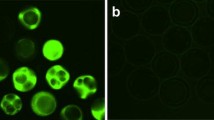Abstract
A retrospective analysis of transgenesis rates obtained in seven pronuclear microinjection programs was undertaken to determine if a relationship existed between the amount of DNA injected and transgenesis rates in the pig. Logistic regression analysis showed that as the concentration of DNA injected increased from 1 to 10 ng/μl, the number of transgenics when expressed as a proportion of the number liveborn (integration rate) increased from 4% to an average of 26%. A similar relationship was found when the number of molecules of DNA injected per picolitre was analysed. No evidence was obtained to suggest either parameter influenced integration rate in mice when the same constructs were injected. The number of transgenics liveborn when expressed as a proportion of ova injected (efficiency rate), increased as DNA concentration increased up to 7.5 ng/μl and then decreased at 10 ng/μl for both species suggesting that at this concentration DNA (or possible contaminants) may have influenced embryo survival. The relationship between efficiency and the number of molecules injected per picolitre was complex suggesting that the concentration at which DNA was injected was a better determinant of integration and efficiency rates. In conclusion, the present study suggests that transgenes need to be injected at concentrations of between 5 and 10 ng/μl to maximise integration and efficiency rates in pigs.
Similar content being viewed by others
References
Bishop JO (1997) Chromosomal insertion of foreign DNA. Repro Nutr Develop 36: 607–618.
Brem G and Muller M (1994) Large transgenic animals. In: Maclean N. (ed.), Animals with Novel Genes. (pp. 179–224) Cambridge University Press, Cambridge.
Brinster RL, Chen HY, Trumbauer ME, Yagle ML and Palmiter RD (1985) Factors affecting the efficiency of introducing foreign DNA into mice by microinjecting eggs. Proc Natl Acad Sci USA 82: 4438–4442.
Burdon TG and Wall RJ (1992) Fate of microinjected genes in preimplantation mouse embryos. Mol Repro Develop 33: 436–442.
Chan AWS, Kukolj G, Skalka AM, and Bremel RD (1999) Timing of DNA integration, transgenic mosaicism and pronuclear microinjection. Mol Reprod Develop 52: 406–413.
Chen C-G, Fisicaro N, Shinkel TA, Aitken V, Katerelos M, van Denderen BJW et al. (1996) Reduction of Gal-al, 3-Gal expression in transgenic mice expressing human H-transfererase. Xenotransplantation 3: 69–75.
Cowan PJ, Shinkel TA, Witort EJ, Barlow, Pearse MJ, d'Apice AJ. (1996) Targeting gene expression to endothelial cells in transgenic mice using the human intracellular adhesion molecule 2 promoter. Transplantation 62: 155–60.
Cowan PJ, Shinkel TA, Aminian A, Romanella M, Wigley PL, Lonie AJ et al. (1998) High-level co-expression of complement regulators on vascular endothelium in transgenic mice: CD55 and CD59 provide greater protection from human complementmediated injury than CD59 alone. Xenotransplantation 5: 184–190.
Cowan PJ, Aminian A, Barlow H, Brown AA, Chen C-G, Fisicaro N, Francis et al. (2000) Renal xenografts from triple-transgenic pigs are not hyperacutely rejected but cause coagulopathy in non-immunosupreesed baboons. Transplantation 69 2504–2515.
Gagne M, Pothier F and Sirad M-A (1997) Gene microinjection into bovine pronuclei. In: Houdebine LM (ed.), Transgenic Animals: Generation and Use. (pp. 27–36). Harwood Academic Publishers, The Netherlands.
Hunter RHF (1974) Chronological and cytological details of fertilization and early embryonic development in the domestic pig Sus scrofa. Anatom Rec 178: 169–185.
Kimura A, Israel A, Le Bail O, Kourilsky K (1986) Detailed analysis of the mouse H-2Kb promoter: enhancer-like sequences and their role in the regulation of class I gene expression. Cell 44: 261–272.
Martin MJ, Houtz J, Adams C, Thomas D, Freemann B, Keirns J et al. (1996) Effect of pronuclear DNA microinjection on the development of porcine ova in utero. Theriogenology 46: 695–701.
McCullagh P and Nelder JA (1989) Generalized Linear Models. 2nd edn., Chapman and Hall, London.
NHMRC (National Health and Medical Research Council) (1997) Australian Code of Practice for the Care and Use of Animals for Scientific Purposes. 6th edn., Australia Government Publishing Service, Canberra.
Nottle MB, Nagashima H, Verma PJ, Du Z, Grupen CG, McIlfatrick SM et al. (1997) Production and analysis of growth hormone transgenic pigs. In: Murray JD, Anderson GB, Oberbauer AM and McGloughlin MM (eds.), Transgenic Animals In Agriculture. (pp. 145–156). CAB International, New York.
Page RL, Canseco RS, Russel CG, Johnson JL, Velander WH and Gwazdauskas FC (1995) Transgene detection during early murine embryonic development after pronuclear microinjection. Transgenic Res 4: 12–17.
Payne RW, Lane PW, Digby PGN, Harding SA, Leech PK, Morgan GW et al. (1995) Genstat 5 Release 4 Reference Mannual. Oxford University Press. Oxford.
Pursel VG, Miller KF, Pinkert CA, Palmiter RD and Brinster RL (1988) Effect of ovum cleavage stage at microinjection on embryonic survival and gene integration in pigs. Proc 11th Int Cong Animal Reproduction and Artificial Insemination 4: 480–482.
Quinn P, Warnes GM, Kerin JF and Kirby C (1985) Culture factors affecting the success rate of in vitro fertilization and embryo transfer. Ann New York Acad Sci 442: 195–204.
Shinkel TA, Cowan PJ, Barlow H, Aminian A, Romanella M, Lublin DM et al. (1998) Expression and functional analysis of glycosyl-phosphatidyl inositol-linked CD46 in transgenic mice. Transplantation 66: 1401–1406.
Wall RJ and Burdon TG (1997) The fate of microinjected genes in preimplantation embryos. In: Houdebine LM (ed), Transgenic Animals: Generation and Use. Harwood Academic Publishers, The Netherlands.
Wall RJ, Pursel VG, Hammer, RE and Brinster RL (1985) Development of porcine ova that were centrifuged to permit visualization of pronuclei and nuclei. Biol Repro 32: 645–651.
Whitelaw CBA, Springbett AJ, Webster J and Clark AJ (1993) The majority of G0 transgenic mice are derived from mosaic embryos. Transgenic Res 2: 29–32.
Author information
Authors and Affiliations
Rights and permissions
About this article
Cite this article
Nottle, M.B., Haskard, K., Verma, P. et al. Effect of DNA concentration on transgenesis rates in mice and pigs. Transgenic Res 10, 523–531 (2001). https://doi.org/10.1023/A:1013007329936
Issue Date:
DOI: https://doi.org/10.1023/A:1013007329936




